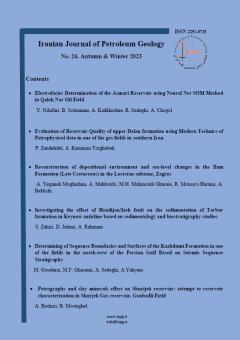Investigating the effect of Hendijan/Izeh fault on the sedimentation of Tarbur formation in Keynow anticline based on sedimentology and biostratigraphy studies
Subject Areas : رسوب شناسی و تحلیل حوضه های رسوبی
sadegh zahiri
1
![]() ,
Davood Jahani
2
,
Davood Jahani
2
![]() ,
Ali Rahmani
3
,
Ali Rahmani
3
![]()
1 - Department of Geology, North Tehran Branch, Islamic Azad University Tehran, Iran
2 - Department of Geology, North Tehran Branch, Islamic Azad University Tehran, Iran
3 - National Iranian Oil Company
Keywords: Tarbur Formation, Maastrichtian, Hendijan paleohigh,
Abstract :
Folding patterns in the Zagros thrust belt are highly influenced by both the mechanical behavior of its rock units and the activity of the Bedrock faults with each Zagrosian and Arabian orientation, and this factor significantly influences the upper deposit sedimentation patterns throughout many areas, and on other occasions it also affects facies distribution and alternate thickness changes. The main goal of this article is to assess the effect of Hendijan-Izeh Fault on deposition of Tarbur Formation (Maastrichtian) in Keynow anticline and its vicinity during field study, satellite imagery geological mapping; and using results from thin sections (33 samples), Four lithofacies were identified, which points toward a carbonate ramp depositional environment, whereas the sediments biostratigraphically display Maastrichtian age. The findings of the article demonstrate that with respect to the Hendijan-Izeh Fault, Tarbur Formation transitions into Gurpi Formation with distance, while Gurpi Formation is deposited where Tarbur Formation would be from the southern limb of Keynow anticline. Therefore, it is concluded that the Hendijan uplift was consequential during the time of Tarbur Formation deposition.
Abdollahie Fard, I., Sepehr, M., and Sherkati, S., 2011, Neogene salt in SW Iran and its interaction with Zagros folding: Geological Magazine, v. 148, no. 5-6, p. 854-867.
Allahkarampour Dill, M., Vaziri-Moghaddam, H., Seyrafian, A., and Behdad, A., 2018, Oligo-Miocene carbonate platform evolution in the northern margin of the Asmari intra-shelf basin, SW Iran: Marine and Petroleum Geology, v. 92, p. 437-461
Falcon, N. L., 1974, Southern Iran: Zagros Mountains, in Spencer, A., ed., Mesozoic-Cenozoic Orogenic Belts, Geological Society of London Special Publication 4, p. 199-211.
Ghabeishavi, A., Vaziri-Moghaddam, H., and Taheri, A., 2009, Facies distribution and sequence stratigraphy of the Coniacian–Santonian succession of the Bangestan Palaeo-high in the Bangestan Anticline, SW Iran: Facies, v. 55, no. 2, p. 243-257.
Ghabeishavi, A., Vaziri-Moghaddam, H., Taheri, A., and Taati, F., 2010, Microfacies and depositional environment of the Cenomanian of the Bangestan anticline, SW Iran: Journal of Asian Earth Sciences, v. 37, no. 3, p. 275-285.
James, G. A., and Wynd, J. G., 1965, Stratigraphic nomenclature of Iranian Oil Consortium Agreement Area: AAPG Bulletin, v. 49, no. 12, p. 2182–2245.
Laursen, G. V., Monibi, S., Allan, T. L., Pickard, N. A. H., Hosseiney, A., Vincent, B., Hamon, Y., Van Buchem, F. S. P., Moallemi, A., and Druillion, G., 2009, The Asmari Formation revisited: Changed stratigraphic allocation and new biozonation, First International Petroleum Conference and Exhibition: Shiraz, Iran.
Nikfard, M., 2023, Lower Eocene carbonate ramp clinoforms of the southern Tethys; Zagros Foreland Basin, SW Iran: Sequence stratigraphy architecture, basin physiography and carbonate factory controlling parameters, v. 35, no. 6, p. 2049-2077.
Parham, S., Piryaei, A. R., Ghorbani, M., and Moussavi-Harami, R., 2019, Paleogeographic evolution of the Maastrichtian deposits in the eastern Fars area (Zagros, Iran) using high-resolution sequence stratigraphic analysis: Carbonates and Evaporites, v. 34, no. 2, p. 315
. Piryaei, A., Reijmer, J. J. G., van Buchem, F. S. P., Yazdi-Moghadam, M., Sadouni, J., and Danelian, T., 2010, The influence of Late Cretaceous tectonic processes on sedimentation patterns along the northeastern Arabian plate margin (Fars Province, SW Iran): Geological Society, London, Special Publications, v. 330, no. 1, p. 211-251.
Rahmani, A., Taheri, A., Vaziri-Moghaddam, H., and Ghabeishavi, A., 2012, Biostratigraphy of the Asmari Formation at Khaviz and Bangestan Anticlines, Zagros Basin, SW Iran: Neues Jahrbuch für Geologie und Paläontologie-Abhandlungen, v. 263, no. 1, p. 1–16.
Sepehr, M., and Cosgrove, J. W., 2002, The major fault zones controlling the sedimentation, deformation and entrapment of hydrocarbon in the Zagros fold-thrust belt, Iran, AAPG Annual Meeting: Houston, Texas, p. 10-13.
-, 2007, The role of major fault zones in controlling the geometry and spatial organization of structures in the Zagros Fold–Thrust Belt: Geological Society, London, Special Publications, v. 272, p. 419-436
. Shabafrooz, R., Mahboubi, A., Vaziri-Moghaddam, H., Moussavi-Harami, R., Ghabeishavi, A., and Al-Aasm, I. S., 2015, Facies analysis and carbonate ramp evolution of Oligo-Miocene Asmari Formation in the Gachsaran and Bibi-Hakimeh oilfields and the nearby Mish anticline, Zagros Basin, Iran Neues Jahrbuch für Geologie und Paläontologie - Abhandlungen, v. 276, no. 1, p. 121-146.
Sherkati, S., and Letouzey, J., 2004, Variation of structural style and basin evolution in the central Zagros (Izeh zone and Dezful Embayment), Iran: Marine and Petroleum Geology, v. 21, no. 5, p. 535–554.
Van-Buchem, F., Allen, T., Gaumet, F., Karimi, Z., Laursen, G., Lotfpour, M., Masse, P., Moallemi, A., Monibi, A., Motiei, H., Tahmasbi, A. R., Vedrenne, V., and Vincent, B., 2006, The evolution of the Oligocene early Miocene mixed sedimentary system in the Dezful Embayment (SW Iran). Geo2006 Abstracts,GeoArabia, 12.
van_Buchem, F. S. P., Allan, T. L., G V Laursen, Lotfpour, M., Moallemi, A., Monibi, S., Motiei, H., Pickard, N. A. H., Tahmasbi, A. R., Vedrenne, V., and Vincent, B., 2010, Regional stratigraphic architecture and reservoir types of the Oligo-Miocene deposits in the Dezful Embayment (Asmari and Pabdeh Formations) SW Iran, in van_Buchem, F. S. P., Gerde, K. D., and Esteban, M., eds., Mesozoic and Cenozoic carbonate systems of the Mediterranean and the Middle East; stratigraphic and diagenetic reference models: London, Geological Society London Special Publications 329, p. 219-263.
Wynd, J. G., 1965, Biofacies of the Iranian consortium- agreement area: Iranian Offshore Oil Company.
